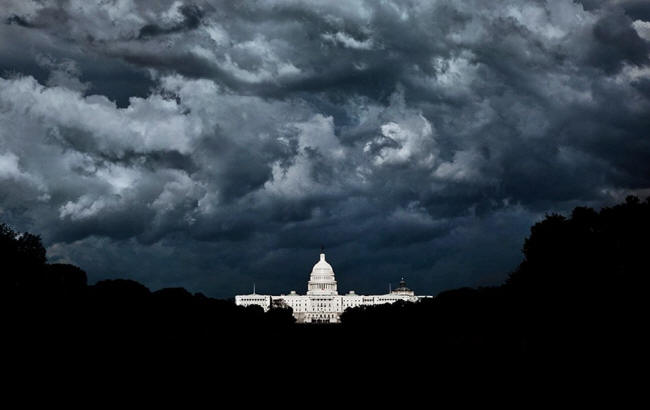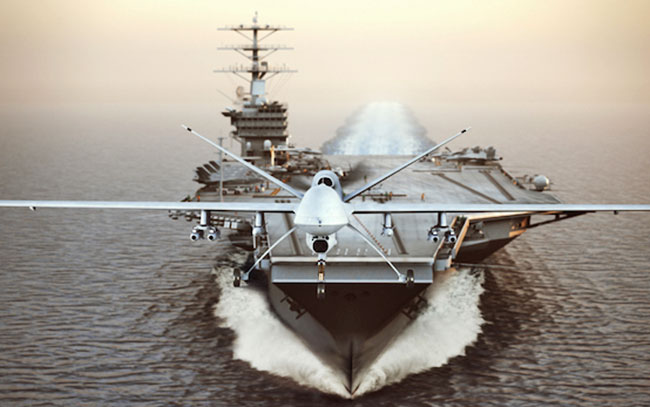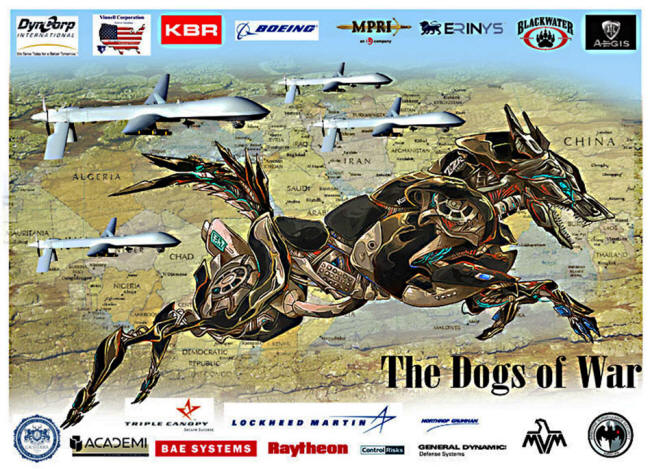|
by Gareth Porter
has come true, as defense mega-contractors climb into the cockpit to ensure we stay overextended.
The result today is a
"permanent-war complex," which is now engaged in conflicts in at
least eight countries across the globe, none of which are intended
to be temporary.
But like the old military-industrial complex, it is really rooted in the evolving relationship between the national security institutions themselves and the private arms contractors allied with them.
And so the drone
contractors - especially the dominant
General Atomics - have both a
powerful motive and the political power, exercised through its
clients in Congress, to ensure that the wars continue for the
indefinite future.
But during the 1990s, both Congress and the Bush and Clinton administrations opened the floodgates to arms and intelligence contractors and their political allies.
The contracts soon became bigger and more concentrated in a handful of dominant companies. Between 1998 and 2003, private contractors were getting roughly half of the entire defense budget each year.
The 50 biggest companies
were getting more than half of the approximately $900 billion paid
out in contracts during that time, and most were no-bid contracts,
sole sourced, according to the
Center for Public Integrity.
The number of these contractors grew so rapidly and chaotically in the two decades after the Cold War that senior Pentagon officials did not even know the full extent of their numbers and reach.
In 2010, then-secretary
of defense Robert M. Gates even confessed to Washington
Post reporters Dana Priest and William M. Arkin
that he was unable to determine how many contractors worked in the
Office of the Secretary of Defense, which includes the entire
civilian side of the Pentagon.
Contractors could pay
much higher salaries and consulting fees than government agencies,
so experienced Pentagon and CIA officers soon left their civil
service jobs by the tens of thousands for plum positions with firms
that often paid twice as much as the government for the same work.
Even President Barack Obama's CIA director Leon Panetta admitted to Priest and Arkin that the intelligence community had for too long,
By 2010, "core
contractors" - those who perform such functions as collection and
analysis - comprised at least 28 percent of professional civilian
and military intelligence staff, according to a fact sheet from the
Office of the Director of National Intelligence.
And both Gates and
Panetta acknowledged to them their concerns about that issue.
A 2010 Boston Globe
investigation showed that the percentage of three- and four-star
generals who left the Pentagon to take jobs as consultants or
executives with defense contractors, which was already at 45 percent
in 1993, had climbed to 80 percent by 2005 - an 83 percent increase
in 12 years.
Not surprisingly McConnell energetically promoted even greater reliance on the private sector, on the grounds that it was supposedly more efficient and innovative than the government.
In 2009 he returned once
again to
Booz Allen Hamilton as vice
chairman.
To some in the military it appeared that the privateers had taken over the Pentagon.
As a senior U.S. military officer who had served in Afghanistan commented to Priest and Arkin,
The operations
in Afghanistan and Iraq were sold
on that premise, even though virtually no al Qaeda remained in
Afghanistan and none were in Iraq until long after the initial U.S.
invasion.
The Air Force owned the
drones and conducted strikes in Afghanistan, but the CIA carried
them out covertly in Pakistan, and the CIA and the military competed
for control over the strikes in Yemen.
From 2004 through 2007,
the CIA carried out 12 strikes in
Pakistan, aimed at high-value targets of al Qaeda and its
affiliates. But they killed only three identifiable al Qaeda or
Pakistani Taliban figures, along with 121 civilians, based on
analysis of news reports of the strikes.
Eventually it became a tool for killing mostly suspected rank-and-file Afghan Taliban fighters in both Pakistan and Afghanistan, particularly during the Obama administration, which had less stomach and political capital for outright war and came to depend on the covert drone campaign.
This war was largely
secret and less accountable publicly. And it allowed him the
preferable optics of withdrawing troops and ending official ground
operations in places like Iraq.
Some mid-level CIA
officers opposed the strikes in Pakistan as early as 2009, because
of what they had learned from intelligence gathered from intercepts
of electronic communications in areas where the strikes were taking
place: they were infuriating Muslim males and making them more
willing to join al Qaeda.
More evidence of that effect came from Yemen.
A 2013 report on drone
war policy for the
Council on Foreign Relations found
that membership in al Qaeda in the Arabian Peninsula in Yemen grew
from several hundred in 2010 to a few thousand members in 2012, just
as the number of drone strikes in the country was increasing
dramatically - along with popular anger toward the United States.
They demonstrate to the public that he is doing 'something' concrete about terrorism, thus providing political cover in case of another successful terrorist attack on U.S. soil.
Donald Trump has shown no interest in scaling back the drone wars, despite openly questioning the stationing of troops across the Middle East and Africa.
In 2017 he approved a 100 percent increase in drone strikes in Yemen and a 30 percent increase in Somalia above the totals of the final year of the Obama administration.
And Trump has approved a
major increase in drone strikes in Afghanistan, and has eliminated
rules aimed at reducing civilian casualties from such strikes.
By 2007 that required more specialists than the Air Force had available.
Since then, the Air Force has been working with military and intelligence contractors to analyze full-motion videos transmitted by drones to guide targeting decisions.
BAE, the third-ranking Pentagon contractor according to defense revenues, claims that it is the "leading provider" of analysis of drone video intelligence, but in the early years the list of major companies with contracts for such work also included,
These analysts were fully integrated into the "kill chain" that resulted, in many cases, in civilian casualties.
In the now-famous case of the strike in February 2010 that killed at least 15 Afghan civilians, including children, the "primary screener" for the team of six video analysts in Florida communicating via a chat system with the drone pilot in Nevada was a contract employee with SAIC.
That company had a $49
million multi-year contract with the Air Force to analyze drone
video feeds and other intelligence from Afghanistan.
The Air Force needed
1,281 drone pilots to handle as many "combat air patrols" per day in
multiple countries. But it was several hundred pilots short of that
objective.
But in April 2015 the Air
Force signed a contract with the company to lease one of its Reapers
with its own ground control station for a year. In addition, the
contractor was to provide the pilots, sensor operators, and other
crew members to fly it and maintain it.
The result of that contract was a complete blurring of the lines between the official military and the contractors hired to work alongside them. The Air Force denied any such blurring, arguing that the planning and execution of each mission would still be in the hands of an Air Force officer.
But the Air Force Judge
Advocate General's Office had published an article in its law review
in 2010 warning that even the analysis of video feeds risked
violating international law prohibiting civilian participation in
direct hostilities.
After 9/11, the military became dependent on the private sector for everything from food, water, and housing to security and refueling in Iraq and Afghanistan.
By 2009 contractors began
outnumbering U.S. troops in Afghanistan and eventually became
critical for continuing the war as well.
The Reapers are normally
armed for independent missile strikes, but in this case, the
contractor-operated Reapers were to be unarmed, meaning that the
drones would be used to identify targets for Air Force manned
aircraft bombing missions.
U.S. government spending on the military drone market, which includes not only procurement and research and development for the drones themselves, but the sensors, modifications, control systems, and other support contracts, stood at $4.5 billion in 2016, and was expected to increase to $13 billion by 2027.
General Atomics is
now the dominant player in the arena.
They have the one-two
punch of strategically focused campaign contributions and intensive
lobbying of members with whom they have influence.
The biggest loser
appeared to be Northrop Grumman's "Global
Hawk" drone, designed for unarmed high-altitude
intelligence surveillance flights of up to 32 hours.
He cited the,
In addition, the Pentagon
still believed the venerable U-2 Spy plane - which could operate in
all weather conditions, unlike the Global Hawk - could carry out
comparable high-altitude intelligence missions.
But that was before
Northrop Grumman mounted a classic successful lobbying campaign to
reverse the decision.
Then the powerful
chairman of the House Armed Services Committee, California
Republican Buck McKeon, and a member of the House
Appropriations Defense Subcommittee, Democrat Jim Moran of
Virginia, wrote a letter to incoming Defense Secretary Chuck
Hagel on May 13, 2013, pressing him to fund the acquisition of
the Global Hawks.
The Air Force issued a
statement pledging to acquire the last three Northrop Grumman spy
planes, and in early 2014, Hagel and Dempsey announced that they
would mothball the U-2 and replace it with the Global Hawk.
Representative Moran, the
co-author of the letter with McKeon, who represented the northern
Virginia district where Northrop has its headquarters, had gotten
$22,000 in contributions.
In the first half of 2013 alone, four major drone contractors,
... spent $26.2 million lobbying Congress to pressure the executive branch to keep the pipeline of funding for their respective drone systems flowing freely.
The Center for the Study of the Drone observed,
Instead of dying down, the demand from drones in Afghanistan has exploded in subsequent years.
By 2016, the General Atomics Reapers had already become so tightly integrated into U.S. military operations in Afghanistan that the whole U.S. war plan was dependent on them.
In the first quarter of
2016 Air Force data showed that 61 percent of the weapons dropped in
Afghanistan were from the drones.
Even though those bureaucracies, along with the CIA, seized the opportunity to openly conduct military operations in one country after another, the drone war has introduced a new political dynamic into the war system:
Eisenhower was prophetic in his warning about the threat of the original complex (which he had planned to call the military-industrial-congressional complex) to American democracy.
But that original complex, organized merely to maximize the production of arms to enhance the power and resources of both the Pentagon and their contractor allies, has become a much more serious menace to the security of the American people than even Eisenhower could have anticipated.
Now it is a system
of war that powerful arms contractors and their bureaucratic
allies may have the ability to maintain indefinitely...
|




